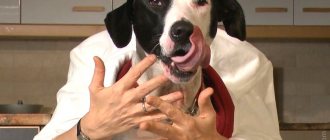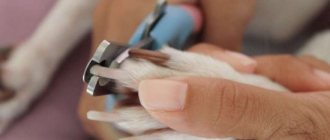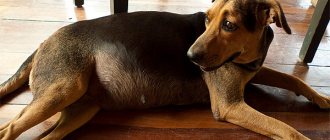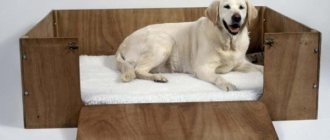Health problems of your beloved pet concern every family member. Any disturbances in activity, refusal to eat and the general lethargic condition of the pet should alert the owner and force him to be more attentive to the health of his pet.
Constipation in a dog seems to be a common thing, but it is worth remembering that stagnation of feces causes great discomfort to the pet. Attempting to go to the toilet in this case may be accompanied by severe pain. Frequent constipation can indicate serious diseases of the gastrointestinal tract and can develop into a chronic disease.
It is normal to have bowel movements approximately twice a day. If the animal does not go to the toilet for more than a day or even several days, then the owner should help his pet empty its intestines. Stagnation of feces can lead to inflammatory processes and dysbacteriosis, increased body temperature and vomiting, because stagnant processes can cause general intoxication of the body.
What is considered constipation in a dog?
Constipation in dogs is incomplete, irregular, severe, or completely absent bowel movements:
- According to general estimates, stool with a frequency of twice every 3 days or pain that occurs in a dog during defecation at a normal frequency can already be considered constipation.
- With constipation, stool accumulates in the intestines, which can dry out, harden and cause not only discomfort in the pet, but also cause injury to the intestinal wall.
- Constipation occurs quite often in dogs, especially in older animals, in animals leading a sedentary life, and also in all ages after feeding the dog bones.
Etiology.
Constipation in dogs can be caused by:
- Violations associated with diet and feeding:
- Feeding the dog table scraps.
- Insufficient amount of fiber and ballast substances in food.
- Feeding with dry food with a small amount of fluid entering the body.
- Feeding food cooked in strong broths or monotonous food.
- General overfeeding of the dog.
- Giving your dog plenty of bones.
- Dehydration.
- Obesity and sedentary lifestyle.
- Rare walks.
- Incorrect use of medications - constipation after diarrhea (side effect after long-term use of astringents).
- Dog disease:
- Diseases of the digestive system (peptic ulcer in dogs, hemorrhoids in dogs), liver (liver disease in dogs) and kidneys (urolithiasis in dogs).
- Recovery of dogs after infectious diseases (canine parvovirus enteritis, canine distemper).
- Fractures of the pelvic bones.
- Inflammation, swelling, abscesses of the prostate and paraanal glands (prostatitis in dogs).
- Blockage of the intestines with foreign objects (bones, toys).
- Volvulus.
- Intestinal atony.
- Worms (worms in dogs).
- Dysbacteriosis of the large intestine.
- Tumors in the intestines or perineal area (oncology in dogs).
- Diseases of the nervous system accompanied by paralysis and paresis.
- Injuries in the spine.
Dog nutrition recommendations
To treat poor bowel movements, dietary adjustments are necessary. The diet should not contain:
- rice, beans, corn;
- rich broths;
- cheeses;
- muscle meat;
- dry food;
- bones;
- fatty food;
- whole milk;
- fresh bakery.
Food is given in small portions in warm and liquid form. Overfeeding the dog is unacceptable. Olive (or other vegetable) oil added 1-2 drops to food will help improve intestinal motility.
Improves bowel function:
- porridge with water or milk:
- fresh or stewed vegetables (carrots, beets, pumpkin);
- boiled sea fish fillet;
- fermented milk products without additives;
- cabbage juice;
- fresh plums or prunes (no more than 2 pieces).
It is strictly forbidden to feed your dog food from your table!
Consequences that a dog may have as a result of prolonged constipation
The consequences of prolonged constipation are quite serious. As a result of prolonged constipation, a dog may experience:
- general intoxication of the body;
- rupture of the intestinal wall;
- disturbances in the functions of internal organs and systems;
- the load on the heart increases;
- Impaired nutrition of the skin, followed by the appearance of itching in the dog (itching in dogs), scratching, and areas of baldness.
* if a dog’s intestines do not empty within 4-7 days, then death occurs.
Clinical picture . Constipation in a dog is manifested by the following main clinical signs:
- the dog strains strongly when trying to defecate, there is difficulty defecating, or the dog’s owners note frequent urges without bowel movements;
- the excreted feces have a dry, hard consistency, feces are sometimes released in small quantities;
- pain, discomfort, accompanied by whining or restlessness of the dog when attempting to defecate;
- due to gas accumulations in the intestines, bloating is noted; upon palpation, the abdomen is hard;
- lack of bowel movements due to lack of feces;
- lack of appetite;
- general state of oppression.
In the case when constipation in a dog is accompanied by vomiting (vomiting in a dog), this is one of the important signs of complete blockage of the intestines. Under these conditions, the owner can carefully insert a finger dressed in a rubber glove and lubricated with vegetable oil into the dog's anus to check for the presence of feces in the rectum. Thus, you can distinguish banal coprostasis from complete intestinal obstruction, in which there may be no feces in the rectum at all.
Prepare before going to the vet
In the office, you may have to provide the veterinarian with all possible assistance (hold the animal while they take blood for analysis, give an injection, extinguish aggression, calm your voice, scratch its ears, stroke it). If you know that you are terrified of blood, IVs, or definitely cannot withstand the type of medical interventions, then perhaps you should ask a friend or relative for help.
Find a veterinary certificate, veterinary passport.
Take:
- Leash;
- Collar;
- Muzzle;
- Carrying;
- A pack of napkins;
- litter;
- Bowl, water (at the veterinarian's discretion)
Prepare answers to possible questions from the veterinarian:
- Are all vaccinations up to date on the animal?
- Pet’s behavior in recent days, appetite;
- His diet;
- What drugs and medicines did you give to the animal;
- Latest test data (if available).
It’s better to make an appointment in advance - you’ll save time and be able to calculate when you’ll have to take time off. This does not apply to life-threatening situations where you will have to take an animal to a veterinary clinic without an appointment.
https://dog-care.ru/zdorove/bolezni/zapor-chto-delat-v-domashnih-usloviyah.html
Be affectionate with your pet, play, talk to him. You can take his favorite toy with you so that while you wait for your turn at the reception, you can distract your friend from the new environment.
Furry, feathered or scaly ones also need to be prepared. No matter how much you want to treat your little one with something tasty, remember: you need an empty stomach. Feeding is prohibited!
You can wash your animal without using detergents. But it is important not to touch your pet if there is nasal discharge, watery eyes, salivation (salivation), dandruff, scratching, rashes, skin scabs, loss of hair/feathers/scales, wounds and other external manifestations of a potential disease.
If the veterinarian has instructed, collect the animal’s urine in a sterile container, and pick up the feces with a stick (no blades of grass, specks, or debris). Transfer the feces into a sterile container. Send to the biochemical laboratory within 6 hours. The feces are examined for eggs of roundworms, pinworms, tapeworms, liver flukes, echinoccus, alvecoccus, pork tapeworm, bovine tapeworm, and gastrointestinal bleeding is detected.
At the veterinary hospital, the animal’s blood will be analyzed for antibodies to allergens, viruses, bacteria, and parasites.
What information should dog owners provide to the treating veterinarian?
When contacting your veterinarian, it is important to provide the following information in more detail:
- the age of the animal and lifestyle;
- when constipation was discovered and how it manifested itself;
- whether the dog has vomited, its frequency and frequency, the type of vomit;
- usual methods and daily frequency of feeding;
- a list of food fed over the last 24 hours;
- changes in behavior, urination, defecation, appetite, thirst.
During a clinical examination of a sick dog, a veterinarian can determine the presence of foreign objects in the intestines, the presence of inflammation of the perineum and anus, problems with the paraanal glands, neurological problems, injuries to the pelvic bones and spine.
To more accurately determine why a dog is constipated, the following may additionally be prescribed in a veterinary clinic:
- general blood analysis;
- abdominal x-ray;
- X-ray of the intestine with contrast to assess its patency;
- Ultrasound of the abdominal cavity.
What to tell your veterinarian
In order for the doctor to quickly diagnose and prescribe treatment, the owner must provide him with detailed information: • The age of the dog; • Pet's lifestyle; • Nutritional features; • Duration of constipation; • Was there any vomiting; • Feeding menu for the last day; • How the pet's behavior has changed; • Is urination impaired; • Presence or absence of appetite.
Symptoms and history are usually sufficient to make a diagnosis. If there are doubts and extraneous signs, other procedures are prescribed: • X-ray of the abdomen. • Blood analysis. • Ultrasound. • X-ray of the intestine to determine its patency.
Treating a dog for constipation
In the case where the cause of constipation in a dog is coprostasis resulting from a lack of fluid in the dog’s body, therapeutic assistance should consist of owners making changes to the feeding diet and allowing the dog to drink plenty of water. We increase the dog's physical activity through frequent walks. It is necessary to give the dog an enema or give one of the folk laxatives. We prescribe medications that help improve digestion and intestinal motility. When a dog is constipated, Vaseline oil helps a lot, which is given to the dog depending on its weight in an amount of 5 to 50 ml per day. Using Vaseline oil, without being absorbed in the intestines, lubricates its mucous membrane and makes stool softer. As a mild laxative, you can use crushed prunes, or use their infusion (prunes are poured with boiling water and left for 2-3 hours).
If a dog with coprostasis additionally constantly worries, then its owners are advised to try the following measures:
- Give the dog an enema.
- Give one of the available laxatives.
- Give no-shpa to relieve intestinal spasms.
- Normalize the feeding diet.
- Prescribe medications to treat possible cracks and microtraumas of the rectum.
- These therapeutic measures can be carried out if you are completely sure that the dog’s constipation was a consequence of coprostasis.
If constipation in a dog is caused by diseases of the internal organs, worms, etc., it is necessary to contact a veterinary clinic at your place of residence for medical help.
Depending on the cause of constipation, a veterinarian will perform the necessary medical procedures.
How is the treatment carried out?
The drugs can be used at home as prescribed by a veterinarian. The risk of unjustified use of drugs is high if the diagnosis is incorrect.
List of medications:
- Magnesia. Promotes the concentration of water in the intestines, softens stool, enhances peristalsis. Contraindications: heart disease, gall bladder, kidney disease.
- Lactusan, Duphalac. They are not absorbed by cells, work only in the intestines, increase the volume of feces and enhance their excretion.
- Bisacodyl (tablets, suppositories).
- Vetelak. Contains lactose, galactose, lactulose, has a laxative effect. Effective for severe constipation, attracts water.
- Lactason. Available in the form of a paste, it is used to remove bezoars from the intestines.
- Vetasil. Herbal remedy, contains plantain, barley.
Medicines for constipation should not be used by pregnant bitches or emaciated animals. Strictly contraindicated in cases of suspected foreign bodies in the gastrointestinal tract or intussusception. Instructions for use, doses, period of use must be followed.
List of folk remedies: vegetable oils, kefir, Vaseline oil orally or as a microenema.
Therapy for a puppy
Constipation in a puppy can develop for the same reasons as in adult dogs. Swallowed hairs form bezoars, which gradually grow into the mucosa, forming intestinal obstruction.
Constipation in newborns occurs due to insufficient massaging of the tummies, when the dog cannot cope on its own (with a large litter) or during artificial feeding.
For bezoars, treatment is prescribed after ultrasound and x-ray. Ingrown hairballs will require surgery.
It is not recommended to give puppies an enema at home; there is a high probability of damage to the rectal wall. In a hospital setting, special agents, chamomile decoction, and oils are used.
How to give a dog an enema at home?
If you are sure that the cause of constipation in your dog is errors in nutrition or overeating, then one of the ways to solve this problem at home is an enema.
If you have never had to do this before, then before giving your dog an enema, you should first consult a veterinarian. A veterinarian will tell you what solutions can be used for constipation in a dog, in what quantity, etc.
Additionally, based on your story, a veterinary specialist can roughly say whether your dog can have an enema at all. According to their characteristics, enemas can be deep or shallow. You can give your dog a shallow cleansing enema at home yourself. In the case when a dog’s constipation lasts for a long time, then only a deep enema can help eliminate the resulting constipation, which can only be done by a veterinarian to avoid complications.
When do you need veterinary help?
Most often, the animal owner can independently help the animal cope with the situation. However, in some cases, specialist help is required. If the following signs occur, you should contact your veterinarian:
- undigested food, blood or foam is found in the animal’s feces;
- the pet refuses to consume food;
- constipation does not go away within 3-4 days;
- the stool exudes the aroma of rot;
- the animal is vomiting.
Note! If the owner ignores these symptoms, his pet may die. You should not experiment with the life of your four-legged friend and self-medicate.
How much solution is needed to wash the intestines?
When determining the amount of liquid for an enema, it is necessary to take into account the dog's live weight.
- For a dog weighing up to 20 kg, the amount of liquid injected into the rectum is about 200 ml.
- If the dog weighs from 20 to 40 kg, administer about 500 ml.
- If the dog weighs 50 kg, about 1 liter of liquid must be injected into the rectum.
To administer an enema to large dogs, use an Esmarch mug, which is hung or held by an assistant at a height of 1 meter. For dogs with low live weight, as well as dogs of small breeds, use syringes or rubber bulbs.
In order to relax the intestines, relieve pain and relieve spasms when administering liquid, before the enema procedure, it is a good idea to inject the dog intramuscularly with Baralgin or No-ShPU (0.1 ml per 1 kg of live weight).
Technique for administering an enema
- Before administering the enema, we measure the temperature of the solution used. If constipation is spastic in nature, the temperature should be 37-39 degrees. If your dog’s constipation continues for several days, the solution should have a temperature of 27 degrees.
- We give the dog an enema by first laying it on its side and putting the dog on a muzzle.
- Lubricate the tip of the syringe and the dog’s anus with Vaseline or sunflower oil.
- We insert the tip of the syringe into the rectum no more than 3 cm deep (in large dogs up to 5 cm). During insertion of the tip, it is necessary to ensure that the dog does not squirm too much, otherwise injury to the rectal mucosa may occur.
- It is necessary to introduce liquid from the pear into the rectum by applying gentle pressure on its walls. Liquid should flow into the rectum without any resistance. If there is difficulty in administering liquid, you need to check the tip for the absence of feces in it. If fluid does not drain into the rectal cavity, owners should immediately stop administering the fluid and seek veterinary attention.
- If the enema administration procedure was carried out as usual, then after administering the enema, the tip is carefully removed from the rectum, and the anus is tightly covered with the dog’s tail. After 5-7 minutes, the dog will be able to get up. After this procedure, it’s a good idea to let the dog out for a walk in order to stimulate intestinal function.
Puppy doesn't poop
Puppies nursed by their mother will defecate frequently after each feeding. So if they don't, you should call for them to evacuate. To do this, after feeding, place the puppy on his back, resting his hand or knees, and placing a pillow under him. Prepare a basin with warm water and cotton wool or gauze. Moisten the cotton and pass it through the genital area and then through the anal area. Do this several times carefully. Lightly rubbing the abdomen also helps.
This type of stimulation mimics your native tongue and causes urination and bowel movements. When your puppy poops, clean and dry the area well.
If your puppy does not urinate or defecate during the day, contact your veterinarian.
Medications used for constipation in dogs
Prescribing medications to dogs suffering from constipation should be carried out by a veterinary specialist after a clinical examination of the sick dog and an accurate diagnosis.
Animal owners should keep in mind that medications with a laxative effect are not prescribed:
- if there are foreign bodies in the intestines (bones, etc.);
- intestinal obstruction;
- pregnancy;
- sick and malnourished dogs.
When giving a laxative drug to their dog, owners must strictly adhere to the dosage and take into account the side effects of the drug.
Magnesium sulfate is a laxative that helps liquefy stool by “pulling” fluid into the intestines and has a pronounced peristaltic effect. Available in powder form and in ampoules as a 25% solution.
Dose: 1-2 g of powder per 1 kg of dog weight or 1 ampoule of a 25% solution diluted in 5-10 ml of boiled water. We put it in the dog's mouth through the toothless edge.
Side effect: increased salivation when taking the drug.
Contraindications: Kidney disease, heart disease, cholelithiasis.
Duphalac is a lactulose-based laxative. Increases the volume of feces and, due to increased peristalsis, facilitates bowel movements.
Dosage: selected individually at the rate of 1 ml of syrup per 1 kg of dog weight. Use twice during the day or at night. Side effects: flatulence is possible, in case of overdose - diarrhea.
Lactusan is a dietary supplement, a source of lactupose.
Dosage: apply in a dose of 1 ml per 1 kg of dog’s live weight.
Side effect: in case of overdose, the dog develops diarrhea.
Bisacodyl is a laxative that increases the amount of mucus in a dog's intestines and at the same time increases intestinal motility. The pharmacy is available in the form of tablets and rectal suppositories; suppositories are a more convenient dosage form for constipation in dogs.
Dosage: suppositories are inserted rectally until they completely enter the rectum. For large dogs, one suppository is inserted 1-2 times a day, for dogs of dwarf breeds - ¼ suppository.
Side effects: intestinal irritation, severe diarrhea and allergies.
Contraindication: diseases of the urinary system and hypersensitivity to the drug.
Mucofalk is a herbal laxative containing powder from the shells of psyllium seeds. Available in the form of sachet bags.
Application: the contents of one package are dissolved in 150 ml of boiled water and given to the dog using a syringe without an injection needle or using a syringe at the rate of 150 ml for a large dog, 75-130 ml for a medium dog and up to 60 ml for a small dog. After administering the medication, owners should offer the dog an additional drink.
Side effects: allergies, intestinal flatulence in the first days of taking the drug.
Vetelakt is a veterinary drug with a pronounced laxative effect; it contains lactupose, lactose and galactose. The drug stimulates the growth of beneficial lactic acid bacteria in the large intestine of dogs and helps increase the “water content” of feces.
Application: used for severe constipation
Dosage: give 1 ml of the drug per 10 kg of live weight of the animal for a month to prevent constipation. For medicinal purposes, it is used in a dose of 2-3 ml per 10 kg of live weight.
When treating constipation in dogs, castor oil should not be used, as it causes severe pain. Sunflower, olive and corn oils are also not used.
Symptoms
A healthy dog goes to the toilet “in a big way” at least 1-2 times a day. The owner should be alerted to a decrease in the number of bowel movements or their absence - not even once in 3 days. However, there is no need to sound the alarm ahead of time. The number of bowel movements largely depends on the age, physiological characteristics, and size of the animal.
If your four-legged pet is alert, playful and cheerful, eats well, and its feces have a uniform consistency, then there is no reason to worry. It’s a completely different matter if, on a walk, you notice how the dog tries, but cannot go to the toilet, strains and at the same time whines and squeals. This means he is constipated.
Other symptoms of constipation:
- the consistency of stool is hard and dry;
- feces are irregular in shape and their quantity is very small;
- there are hairballs in the stool;
- the abdomen is hard, swollen (due to the accumulation of gases), painful on palpation;
- lack of appetite due to intestinal obstruction;
- increased thirst;
- vomit;
- feverish condition;
- malaise, apathy, decreased activity.
In advanced cases, the feces contain blood, undigested food, and an unpleasant putrid odor is felt.
Preventing constipation
Prevention of constipation in dogs by animal owners should be based on preventing the causes that cause constipation in the dog. Animal owners must:
- exclude small and soft bones from the diet, which can be a source of traumatic intestinal damage to the dog;
- Take daily active walks with your dog in the fresh air;
- During a walk, make sure that the dog does not grab stones, toys, etc. in its mouth. which can cause intestinal blockage;
- Regularly treat your dog for worms;
- when feeding a dog with dry food, the dog must have free access to water;
- add fiber-rich foods (vegetables, bran and cereals) to the diet;
- do not allow the dog to injure the pelvic area and spine;
- Prevent the occurrence of diseases of the digestive system, liver and genitourinary system in your dog;
- provide your dog with a complete diet (golden rules for rational feeding of dogs, feeding pregnant females, feeding aging dogs, feeding puppies);
- Prevention of constipation in dogs should include compliance by owners with zoohygienic rules for feeding and keeping dogs. Regularly vaccinate your pets against viral infectious diseases of dogs common in your region.
Coprostasis
Improper feeding of your pet leads to the development of the disease coprostasis. It occurs as a result of the dog feeding on bones or eating large portions. It is worth noting that constipation from bones occurs extremely often in dogs. The disease also affects male dogs suffering from prostate enlargement. The latter factor is directly related to the formation of constipation; as a result of the increase, the intestines are compressed, and feces cannot come out.
An additional reason for difficulty in passing feces is the presence of damage to the pelvic region, a factor that greatly affects the condition of the intestines. In such cases, pets need to take laxatives. Dogs suffering from coprostasis are easy to identify; the dogs are always restless and periodically run around to defecate to no avail. The belly of such dogs is somewhat swollen.
Dogs suspected of having a disease are sent to a hospital for an X-ray examination with contrast of the intestinal area. Mild conditions can be cured in the simplest ways, for example, with the help of antispasmodics.
Another effective medicine is considered to be a combination of petroleum jelly (20) and castor oils (1). Severe cases require surgery. An enema for a dog with constipation is carried out under general anesthesia, and the procedure is supplemented by removing feces using obstetric forceps. To avoid complications of the situation, feeding the dog with a full intestine is not allowed.











